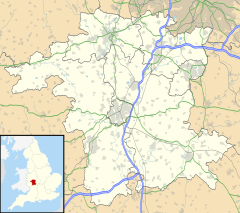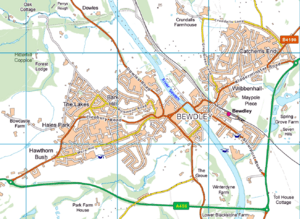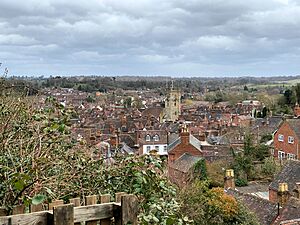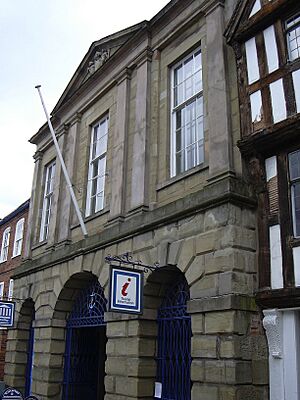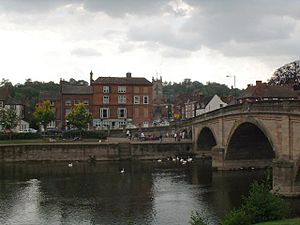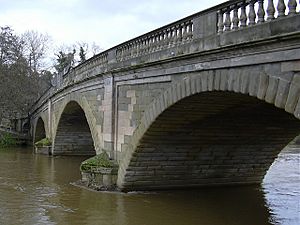Bewdley facts for kids
Quick facts for kids Bewdley |
|
|---|---|
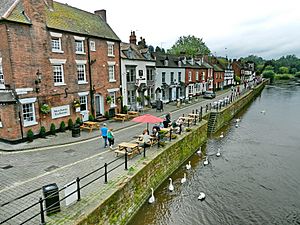 The River Severn at Bewdley |
|
| Population | 9,267 (2021) |
| OS grid reference | SO785752 |
| • London | 134 mi (216 km) |
| Civil parish |
|
| District |
|
| Shire county | |
| Region | |
| Country | England |
| Sovereign state | United Kingdom |
| Post town | BEWDLEY |
| Postcode district | DY12 |
| Dialling code | 01299 |
| Police | West Mercia |
| Fire | Hereford and Worcester |
| Ambulance | West Midlands |
| EU Parliament | West Midlands |
| UK Parliament |
|
Bewdley (pronounced BEWD-lee) is a lovely town in Worcestershire, England. It sits right on the banks of the River Severn. The town is part of the Wyre Forest District and is known for its beautiful scenery.
Bewdley is about 3 miles (5 km) west of Kidderminster and 10 miles (16 km) north of Worcester. It's also near the amazing Wyre Forest nature reserve. In 2021, about 9,267 people lived here. Bewdley is a popular place for tourists. People love its famous Bewdley Bridge, which was designed by Thomas Telford. The town also has many well-preserved buildings from the Georgian period along the river.
Contents
Exploring Bewdley Town
Most of Bewdley is on the west side of the River Severn. This includes the main street, called Load Street. The name "Load" comes from an old word for a ferry, which used to cross the river here. Load Street is very wide because it was once the town's busy market place.
You'll find most of Bewdley's shops and services along Load Street. At the top of this street is St Anne's Church. It was built between 1745 and 1748.
Beyond the church, High Street goes south towards Stourport. This road is sometimes called "the switchback" because it has many sharp turns. High Street is named this way not because it's important for shops, but because it's located 'high' above the river.
On the west side of the church, Welch Gate climbs steeply up. This road once had a tollgate on the way to Wales. It leads to the south side of the Wyre Forest. Another road, Dowles Road, goes northwest towards Button Oak, along the east side of the Wyre Forest. To the northeast of town is Wassel Wood, a wooded hilltop.
Between Stourport and Bewdley, there are several large country houses. Some important ones include Witley Court, Astley Hall, and Pool House.
Bewdley's Past
People have lived in the Bewdley area for a very long time! Scientists found tools and other signs of settlers from the Mesolithic period (around 6,800 BC) in Wribbenhall, which is now part of Bewdley. This makes it the oldest known settlement in Worcestershire.
The area of Wribbenhall, on the east side of the Severn, was mentioned in the Domesday Book. By the 1300s, the town was called Beau lieu, which is French for "Beautiful place." Later, in the 1500s, a writer named John Leland said Bewdley was a town "a man cannot wish to see better."
King Edward IV gave Bewdley special "borough" status in 1472. This meant it could have its own weekly market. Bewdley kept this status until 1974.
In the late 1700s, a banker named Samuel Kenrick lived in Bewdley. He wrote many letters about life in the town. He even described visits from the famous preacher, Rev. John Wesley, who had a small group of followers in Bewdley.
During World War II, Ribbesford House in Bewdley was used by Free French officer cadets. These were 200 teenagers who trained there before joining other allied forces in the D Day invasion.
The old quayside on the west bank of the river has been greatly improved. Its rows of Georgian buildings look wonderful from Telford's bridge. After new flood defences were built in 2006, a "Civic Space" was created. It's now used for events like the Bewdley Riverside Market.
How Bewdley is Governed
Bewdley has three levels of local government that help run the town. These are the Bewdley town council, the Wyre Forest district council, and the Worcestershire county council.
For many years, Bewdley had its own Member of Parliament (MP). An MP is a person elected to represent the area in the UK Parliament. One famous MP for Bewdley was Stanley Baldwin, who was the Prime Minister three times between 1923 and 1937.
Because the number of people living in the area changed, Bewdley's own MP seat was removed in 1950. The town then became part of the Kidderminster constituency. In 1983, it became part of the Wyre Forest constituency. The current MP for Wyre Forest is Mark Garnier.
River and Bridges
The River Severn used to flood often in winter, causing damage to homes and businesses in Bewdley. Some of the worst floods happened in 1947, 1968, and 2000. After the 2000 floods, new flood defences were built on the western bank. These were finished in 2006 and cost £7 million. Temporary barriers are also put up to protect properties on the eastern side of the river in Wribbenhall. In 2023, work started on permanent flood defences for the eastern bank.
The famous Bewdley Bridge over the Severn was built in 1798 by Thomas Telford. It replaced an older medieval bridge from 1483 that was washed away in a flood in 1795. A newer road bridge, called the Bewdley bypass, opened in 1987 to help traffic flow better around the town.
There was once a railway line, the Tenbury and Bewdley Railway, that branched off the Severn Valley Railway at Bewdley. It crossed the river at Dowles on a bridge built in 1865. This railway bridge was taken down in 1965, but its large brick and stone pillars can still be seen.
Education in Bewdley
Bewdley has three state schools. There are two primary schools: St Anne's CE Primary School and Bewdley Primary School. Both opened in 2007.
The main secondary school is The Bewdley School. This school offers courses for GCSE and A Level exams. In 2019, The Bewdley School won 'Secondary School of the Year' at the Worcestershire Educational Awards.
An older school, Bewdley Grammar School, closed in the 1800s. Its building is now used for art galleries and craft activities. Later, Bewdley High School & Sixth Form Centre was built. This school closed in 2007 when the local education system changed. The Bewdley School then opened with new buildings and facilities for arts, science, and outdoor learning.
Local Media
For local news and TV, people in Bewdley watch BBC West Midlands and ITV Central. They can also listen to local radio stations like BBC Hereford and Worcester and Heart West Midlands. The town is served by local newspapers such as The Shuttle and Express & Star.
Fun Things to Do in Bewdley
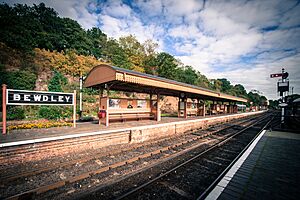
Events in Bewdley
Bewdley hosts one of the biggest inland river regattas (boat races) in the country. The Bewdley Beer Festival happens every August Bank Holiday weekend. There's also an annual Bewdley carnival in June. The Bewdley Festival, which features different artistic performances, takes place every October.
Music Scene
Bewdley has a lively music scene, especially for country music. It has many small music venues and local festivals like the One Earth Festival and Bewdley Live. Robert Plant, the famous singer from Led Zeppelin, lives nearby and sometimes performs at the River Rooms. This is a small music venue that attracts country, soul, rock, jazz, and pop performers from all over Europe and North America.
Other Attractions
The West Midlands Safari Park is located very close to Bewdley. It's a great place to see amazing animals!
The Severn Valley Railway used to have its main office in Bewdley. This heritage railway runs for 16 miles (26 km) between Kidderminster and Bridgnorth. Bewdley is the main stop along the line.
The Queen Elizabeth II Jubilee Gardens, often called "Jubilee Gardens," are a nice place to relax. They are just off High Street.
Bewdley is on the edge of the Wyre Forest, which has many paths for walking and cycling. There's a visitor centre just outside Bewdley at Callow Hill. It's the starting point for many marked trails through the forest. Knowles Mill, an old corn mill, is also in the forest.
The Bewdley Museum explores the town's history. It's located in the old butchers' market area, behind Bewdley Guildhall.
Just outside Bewdley is Beaucastle, a Victorian house built in 1877. It looks like a mock-Gothic castle.
Famous People from Bewdley
- Stanley Baldwin, who was the Prime Minister of the UK three times, was born in Bewdley in 1867. He was the town's MP for almost 30 years.
- John Beddoe, a scientist who studied human races, was born here in 1826.
- Alun Evans, a footballer who became a very expensive teenage player in 1968, was born in Bewdley.
- Becky Hill, a popular singer, is from Bewdley.
- Will Holland (also known as Quantic), a musician and DJ, is from Bewdley.
- Karl Hyde, a musician best known from the band Underworld, was born in Bewdley.
- Rustie Lee, a TV chef and actress, has lived in the Bewdley area for many years.
- Robert Plant, the lead singer of Led Zeppelin, lives in a nearby village and is a member of Bewdley's tennis and rowing clubs.
- Kayleigh Pearson, a model, grew up in Bewdley.
- Luke Woodhouse, a professional darts player, is from Bewdley.
- Mary Whitehouse, a campaigner for cleaner media, lived in Bewdley in the late 1960s.
Twin Towns
Bewdley is twinned with these towns:
- Fort-Mahon-Plage, France
- Vellmar, Germany
- Clarksville, United States
See also
 In Spanish: Bewdley para niños
In Spanish: Bewdley para niños


